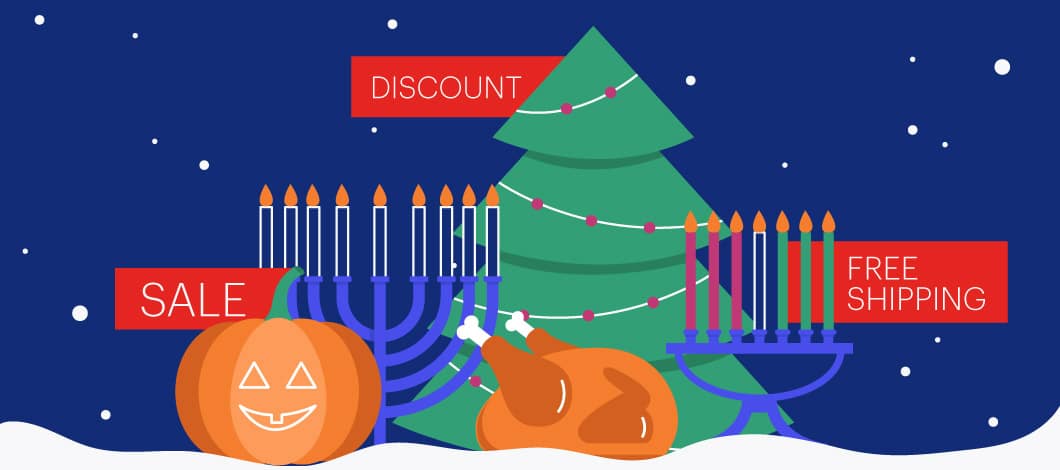Good tidings: Holiday marketing ideas can jump-start your seasonal sales performance.
Here are 16 winning holiday marketing tips you can use:
- Set goals for your holiday marketing campaigns
- Set up holiday marketing metrics
- Estimate your holiday marketing budget
- Create a holiday marketing schedule
- Develop offers for holiday promotions
- Suggest gift ideas
- Update your digital properties
- Prepare your sales infrastructure
- Identify potential promotional partners
- Create holiday promotional content
- Promote content on social media
- Create holiday ads
- Promote your holiday campaign to your email list and text contacts
- Send holiday cards
- Track your holiday campaign performance
- Test adjustments and make improvements
Learn how to put these holiday marketing strategies into practice for a profitable New Year.
1. Set Goals for Your Holiday Marketing Campaigns
An effective holiday sales strategy should aim to accomplish specific goals. You can define your goals by using questions to help you brainstorm. Is the purpose of your holiday campaign to:
- Increase brand awareness?
- Drive traffic to your website?
- Add leads to your social media following and email subscriber list?
- Generate sales from new customers?
- Increase purchases from existing customers?
- Promote a new product or service?
- Increase online sales?
- Drive in-store sales?
- Generate referrals?
How you define your goals will determine which steps you should take. For example, a campaign designed to increase brand awareness may require content and ads to reach your target audience on social media. On the other hand, a campaign to generate sales from existing customers may require a stronger focus on tactics such as email and text marketing.
2. Set Up Holiday Marketing Metrics
Quantifying your goals in terms of key performance indicators (KPIs) will make it easier to plan your holiday campaign and track your results. Depending on the goals of your campaign, relevant KPIs may include:
- Social media metrics, such as likes and shares
- Search engine optimization (SEO) metrics, such as traffic volume and conversions
- Email marketing metrics, such as new subscribers and open rates
- Sales metrics, such as revenue and average value per purchase
Select KPIs which correspond to your goals. For example, if your goal is to build brand awareness, it will be important to track metrics which measure social media engagement and website traffic.
3. Estimate Your Holiday Marketing Budget
Your marketing budget will set a limit on which promotional tactics you are able to use, so you should plan your expenses out before embarking on a campaign. Possible expenses may include:
- Website development and design
- Content development
- Social media management
- Email marketing
- Inventory purchases
- Sales force payroll
- Customer service payroll
Determine which items need to be included in your budget and how much to allocate to each item. These numbers may be adjusted as your campaign concept develops and as you evaluate the performance of specific tactics.
4. Create a Holiday Marketing Schedule
Many marketers only think of holidays at the end of the year while trying to come up with Christmas business promotion ideas. But there’s more to holiday promotions than just Christmas marketing ideas.
If you’re creative, you can come up with innovative holiday marketing strategies for holidays at almost any time of the year, including:
- New Year’s
- Valentine’s Day
- St. Patrick’s Day
- Easter
- Mother’s Day
- Father’s Day
- Independence Day
- Back-to-school shopping
- Labor Day
- Halloween
- Thanksgiving
- Hanukkah
- Kwanzaa
- Christmas
You can generate holiday advertising ideas throughout the year by planning a holiday marketing schedule in advance. Review a list of holidays for each month of the upcoming year. Decide which ones would best suit your target audience and overall marketing strategy. You may find that certain holidays are especially suited to niche markets.
For example, an ecommerce company that sells candy might focus its holiday marketing on Valentine’s Day, Halloween, Thanksgiving, Hanukkah and Christmas.

5. Develop Offers for Holiday Promotions
A winning marketing campaign depends on a compelling offer. A strong offer should promise a unique value that is desirable enough to outweigh the cost of whatever action you’re asking your prospects to take, whether that action is clicking a link, signing up for a list or making a purchase.
You can make an offer more enticing or less risky to the prospect by using techniques such as:
- Offering something exclusive that isn’t available elsewhere, whether it’s information or a product or service
- Adding value by bundling items together or including free bonuses
- Providing customized selection options
- Offering discounts
- Offering customer financing payment options
- Offering free shipping
- Promising superior service
- Reducing risk through free trials, guarantees or warranties
- Making an offer specific to the needs of a niche market, such as customers in a specific geographical location
Use these techniques to develop offers relevant to specific holidays. You may find that a certain holiday naturally suggests an offer. For instance, a company that sells laptops to students could easily adopt the discount offer tactic to develop a back-to-school discount offer.
6. Suggest Gift Ideas
Holiday offers also can include gift offers. If your product or service would make a good gift, this opens up the scope of your target market beyond your direct audience to their family and friends, creating additional opportunities. As you’re developing holiday offer ideas, consider whether you can pitch your offer as a gift suggestion.
Bear in mind that a gift doesn’t necessarily have to be a purchase. You can also offer information as a gift for your audience to share with their social media and email friends and followers. This can be an effective way to extend the reach of promotional videos, memes and blog content.
Gifts can also be extended by you to your customers. Offering free information or a free bonus allows you to extend holiday goodwill to your customers, and can create an opportunity for an upsell offer. You also can present a discount offer as a gift.
7. Update Your Digital Properties
Before launching a major holiday promotion, make sure your digital properties are ready for shoppers. Review your:
- Website
- Social media profiles
- Local search listings
Make sure that all product and pricing details, links, contact information and other important details are current. For your website, you may need to add items promoting your holiday offer, such as a landing page, banner or holiday background theme.
8. Prepare Your Sales Infrastructure
Before launching a holiday campaign, you should prepare for increased sales volume. Review a checklist of key sales infrastructure items:
- Will you have enough inventory available?
- Is your logistics system prepared to handle increased shipping volume or free shipping offers?
- Will you need to hire additional sales staff or implement automation to handle increased order volume?
- Will you need to hire additional customer service support or implement customer service automation?
To answer these questions, you should first do some sales estimates to get an idea of what type of sales volume you’ll need to handle. This will help you determine what steps you may need to take to prepare your sales infrastructure for the holiday shopping season.
If you determine you need to invest in expanding your sales or customer service infrastructure, consider whether a business loan request or other financing method might help you cover your increased seasonal expenses.
9. Identify Potential Promotional Partners
A great way to multiply the outreach of your holiday campaign is getting promotional partners to support your efforts. Look for partners who already have your target market among their customers but are not direct competitors with your business. This can include online partners as well as local businesses.
To persuade partners to support your promotion, you should offer them something of value in exchange. Examples of approaches you can take include:
- Sharing a percentage of revenue generated by their referrals
- Mutually cross-promoting their business to your audience
- Offering a discount to their customers to improve their customer relations
After securing your partner’s cooperation, make it easy for them to promote you by providing them with instructions and resources on how they can support your promotion. For instance, if they’ve agreed to promote you to their email list, you can provide an email template for them to use and guidelines on when to send it out.

10. Create Holiday Promotional Content
Posting holiday-related content on your blog can increase traffic to your site in preparation for your promotion. You can develop content that targets holiday-related keywords and themes. For instance, a company selling a tax-preparation app might take the holiday season as an opportunity to provide year-end tax tips.
Content which is relevant to your audience throughout the year can also be posted during the holiday season to promote traffic. In some cases, you may be able to give such evergreen content a holiday slant. But even if you post content without a holiday theme, as long as you post it during the holiday season, it can serve to draw traffic to your site and support your promotion.
11. Promote Content on Social Media
Social media provides a powerful tool for sharing your holiday blog content. In addition to using social media to share blog content, you also can develop holiday content specifically geared towards your social media profiles, such as videos and memes.
You can use social media content to directly showcase your holiday promotion, or you can indirectly promote it by drawing attention to your brand. For instance, if your target market is a certain age group, a humorous Halloween video featuring a horror character which would be known to your audience might earn some social shares.
12. Create Holiday Ads
Advertising on search engines can extend the reach of your blog content and social media campaigns. You can also place ads that directly promote your holiday sales offer.
Holiday advertising doesn’t have to be restricted to digital channels. Consider whether your promotion might be aided by conventional advertising channels such as local television ads, radio spots, newspaper ads or magazine ads.
13. Promote Your Holiday Campaign to Your Email List and Text Contacts
Your blog content, social media posts and ads can all serve to drive visitors to your site, where you can invite them to sign up for your email list and text marketing messages. This enables you to follow up with emails and texts promoting your holiday offer.
You can use email and text messages in several ways to support your holiday promotion:
- Schedule automated message sequences for new subscribers which culminate in a direct sales offer.
- Send out one-time messages directly extending your offer.
- Send out alerts notifying your audience of new blog and social media posts, raising brand awareness and indirectly promoting your offer.
Use these tactics individually or combine them for greater effect.
14. Send Holiday Cards
Holiday marketing doesn’t have to be limited to digital tactics. The tradition of sending holiday cards can be used to promote your seasonal business offer. Sending a physical card can help you stand out from competitors who only use digital promotions.
A holiday card campaign doesn’t have to be expensive. A simple postcard can be a cost-efficient way to extend your holiday offer to your audience.
15. Track Your Holiday Campaign Performance
To make sure your holiday campaigns are achieving their intended purpose, be sure to track your performance. You can do this by using the KPIs you selected when you were setting your campaign goals.
To make your tracking data accessible, you can use analytics software that allows you to create customized dashboards and reports highlighting your key metrics. Set up a regular review routine and schedule to ensure that your key team members are keeping up with your data.
16. Test Adjustments and Make Improvements
If your campaign numbers aren’t achieving the results you want, or if you simply want to improve your performance, you can try making adjustments. A different keyword in a blog post or a different headline or image in an ad may have a big impact on your results.
You can test the effectiveness of changes to your campaigns by running different versions of content or ads and tracking which version generates the best results, a process known as A/B testing or split testing. Analytics software can be used to run split tests on your website, and platforms such as Facebook include built-in analytics tools designed for split testing. If you don’t have experience running A/B tests, a professional marketing agency can assist you.
Invest in Holiday Marketing to Drive Annual Sales
Putting these holiday marketing tips into effect can help you increase your sales during the holiday season and throughout the new year.
For best results, your holiday promotional strategy should form part of a comprehensive marketing strategy that guides your efforts over the course of the entire year, giving you ample time to plan for the holidays.
If you need to hire a marketing agency or additional sales or customer service representatives to assist you with your holiday promotions, consider using a loan, business line of credit or other form of financing to shore up your budget.











